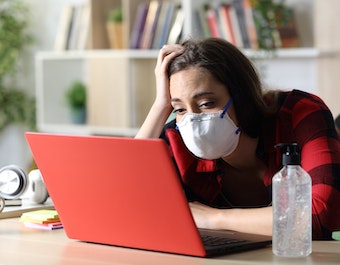In the midst of the global COVID-19 pandemic, many of us are dealing with big changes to our day-to-day lives. Social distancing recommendations and stay at home orders across the country mean that many of us now work from home, have kids home from school, and stay away from social gatherings. That can be a recipe for social isolation and its negative health effects –– but it doesn’t have to be.
Being lonely, anxious, and cooped up can have real detrimental effects under normal circumstances, and these are anything but normal circumstances. “If you wanted to set a perfect recipe for anxiety, it would be a mix of increased risk, increased uncertainty, and disruption of routine,” says Caroline Adelman, PhD, a licensed clinical psychologist and the clinical director of Chicago Psychotherapy. “Our brains love patterns and predictability. It’s inherently stressful for human beings when we start lacking predictability, especially in the face of an actual threat. It’s a really understandable time for folks to be anxious and stressed.”
But with a little foresight, mindfulness, and creativity, you can find intentional ways to try to stay healthy while staying home and maintaining physical distance from those you don’t live with. Here are the do’s and don’ts for weathering this pandemic from home.
Don’t: Get swept up in every headline
Do: Focus on a few trusted sources
As the status of COVID-19 changes on a daily basis, it can be hard to avoid the constant bombardment of stress-inducing headlines. But is it really important to read or listen to every coronavirus news story you come across?
“Too much access to the news, especially about something that’s a major crisis situation, can increase your anxiety and your acute stress,” says E. Alison Holman, PhD, FNP, an associate professor at the University of California, Irvine’s Sue & Bill Gross School of Nursing. “Limit the amount of time you spend paying attention to the media. If you find that push notifications on your phone are alarming you, then stop your push notifications.”
That doesn’t mean that you have to tune everything out across the board. Instead, be intentional about where you’re getting your news from, Adelman says. Trade in endless social media scrolling for a few trusted sources, checked once or twice a day.
“Set boundaries around what kinds of news sources you’re looking at and what kinds of stories you’re tuning into,” says Adelman. “Notice whether they actually provide information or just amp up your anxiety.”
Gathering smart information and guidelines for your specific community can actually give you more agency during an uncertain situation, says Holman.
“Pay attention to the advice from the Centers for Disease Control and Prevention and the World Health Organization,” Holman says. “They are telling us to wipe down surfaces, to wash our hands for 20 seconds, to keep a distance of six feet from other people. All of those recommendations are ways that we can have more control over what’s going on. And one of the best ways to reduce your anxiety is to assert your control.”
Don’t: Dwell on isolation
Do: Stay in touch with friends and family
Just because you need to maintain physical distance from your close friends and family doesn’t mean that you need to distance yourself emotionally or socially. In fact, the opposite may be true.
“Staying connected with people is really important,” says Holman. “It’s one of the ways that human beings survive in dire situations.”
Luckily, there’s a wide variety of ways to stay in touch with those you love in the digital age. Adelman suggests getting creative. Schedule happy hours by video conference, play app-based games against friends, and watch movies with family members virtually using Netflix’s new Party feature.
“I really like the idea of kids being pen pals with each other because it creates a daily academic routine in addition to letting them share and connect,” Adelman says.
Don’t: Get stuck on the couch
Do: Find ways to move
You don’t need to sacrifice your workout routine or daily walks just because gyms are closed and playgrounds are off limits. Staying active will boost both your physical and mental health while you’re stuck at home, Holman says.
“When the anxiety starts to build up you may have excess energy,” she says. “Do something fun with it. There are lots of ways to exercise in your home. You can dance, you can do other things, but make it fun.”
Also know the guidelines for your local area. You likely can still walk or run outside, as long as you make sure to maintain at least six feet between yourself and others.
“Get outside and get some fresh air,” Holman says. “Step outside out on the front porch of your house and take a deep breath. Do things to make sure that your blood is flowing, that you’re getting fresh air and that you’re moving.”
Don’t: Hoard food and supplies
Do: Find healthy and creative ways to use pantry staples
“We are seeing a lot of social contagion, where people learn about other people going to the store and finding the stores empty,” Holman says. “Then they get worried and they go and do the same thing.”
Long story short, there’s no need to hoard toilet paper. While it can be easy to get swept up in worries about access to food and supplies, it’s important to remember that grocery stores are not planning on closing, even in the cities and states experiencing shelter in place orders. By making sure you only take as much as you need, you can make sure that there are enough essentials for everyone in your community.
And if you’re trying to limit your grocery store trips by dipping into your pantry stock, there are plenty of creative and healthy meals you can cook up. Find recipes for staple-heavy meals to keep you well fed, like these 3-Ingredient Pantry Dinners, and 5 Weeknight Recipes in 25 Minutes or Less.
“Try to avoid junk food, which can actually have a powerful effect on your mood,” Holman suggests. “I would encourage people to try to, as best they can, eat foods high in nutrients. Fruits, vegetables, whole grains, and legumes, et cetera.”
Don’t: Let your anxiety get the best of you
Do: Practice mindfulness
“Self-monitor and pay attention to what’s going on inside your body,” Holman suggests. “Is this interaction raising my anxiety? Are these push notifications raising my anxiety? If so, maybe I need to say no, I’m not going to do this anymore.”
When anxiety does begin to bubble up, seek out mindful ways to deal with it that work for you. Breathing exercises, meditation, chatting with a friend, and staying active can all help. Holman suggests the Four, Seven, Eight breathing technique, which involves breathing in for four counts, holding for seven, and exhaling for eight. Repeat the exercise four times.
“That kind of breathing can actually physiologically impact your body in a way that calms you down,” she says. “Use that kind of breathing if you’re finding yourself really amped up.”
Don’t: Endlessly reassure your kids
Do: Be honest with them
“If your child’s asking you the same question over and over, answering it once is information,” says Adelman. “Answering it more than once is reassurance. Reassurance gives us temporary relief from anxiety and everyone feels better for a moment. But it accidentally sends the message to the child that they’re only OK because you told them they’reOK. They will need to keep asking every time to get that feeling.”
Instead of trying to hide the situation from your child, or, on the other end of the spectrum, telling them everything is fine, Adelman suggests being as honest as you can be, based on their age and maturity level.
“It’s important to tell kids that we’ll do everything we can to prevent this, but if you get COVID-19, you’ll probably feel like you have a cold or a flu, or you might feel nothing at all,” she says. “Tell them that for some people in our community, this can be really dangerous. We can take care of each other by washing our hands regularly. Help kids feel like they can focus on the things within their control and realize that this is about care for community, not just care for self.”
Don’t: Go into vacation mode
Do: Keep a regular schedule
“Regular schedules are important,” Holman says. “Make sure you get plenty of sleep and have a regular schedule, like the one you have at work. Get up around the same time. Don’t let yourself feel like you’re all of a sudden on vacation.”
Though of course it won’t be possible to keep everything the same while practicing social distancing, structuring your day and finding ways to create a sense of normalcy can make the situation less stress-inducing.
“Think about the routines that you can find ways to adapt because you know that they reliably serve you,” says Adelman. “If I opt not to take my kids to the playground, what are other healthy ways that my family can get exercise on a reliable basis?”
You may uncover a new activity — say, family dance parties or yoga-plank challenges — that you like so much they remain part of your routine, even after the pandemic has passed.
KATE ROCKWOOD
Rally Health





